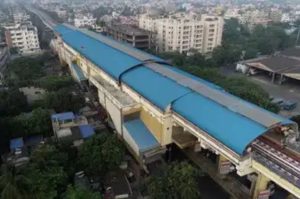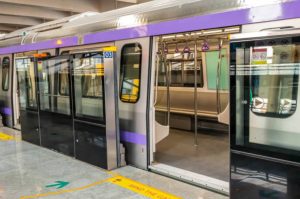Kolkata Metro Purple Line Extension: The ongoing development of Kolkata’s Metro Rail infrastructure has taken a significant turn with a strategic redesign of the Purple Line extension to IIM-Calcutta. This ambitious move by Rail Vikas Nigam Ltd (RVNL) and STUP Consultants is not just a routine engineering adjustment—it marks a forward-looking step toward integrating South Kolkata with the existing North-South Metro corridor, also known as the Blue Line.
As the city’s urban sprawl grows and the need for seamless connectivity becomes ever more pressing, this redesign could serve as a model for sustainable, future-ready metro infrastructure. In this article, we explore the background of the project, the technical details of the redesign, implications for urban mobility, and expert and public reactions to the transformation.

Kolkata Metro Purple Line Extension: The Vision Behind the Purple Line
The Kolkata Metro Purple Line, also known as Line 3, was conceptualized to connect Joka in the southern fringe of Kolkata with Esplanade in the heart of the city. This east-west corridor spans several critical residential and institutional zones, including the prestigious Indian Institute of Management Calcutta (IIM-C).
Phase 1 of the line—running from Joka to Taratala—was inaugurated by Prime Minister Narendra Modi on December 30, 2022, and has been operational since. However, the extension to IIM-Calcutta has faced several logistical and engineering hurdles, which the current redesign seeks to overcome.


Redesign: From Single Piers to Portal Piers
What’s Changing?
According to RVNL officials, the original design used single piers—vertical columns typically seen in standard viaduct structures. However, in light of structural integrity and future expansion plans, STUP Consultants, the newly appointed engineering firm, has suggested a significant alteration.
The new design replaces single piers with portal piers, which are essentially two-legged pillars with a horizontal beam on top—resembling an arch or gateway. These structures not only provide greater support but also allow for additional load-bearing capacity, which is critical if the line is to be integrated with the North-South Metro (Blue Line) in the future.
Why the Redesign?
The decision wasn’t merely technical; it was also strategic. The revised design considers a proposed future metro link from IIM-C to Diamond Park via Thakurpukur, ultimately connecting to Tollygunge station on the Blue Line. For such an ambitious integration, stronger foundational structures are essential.
Location and Structural Implications
Revised Station Placement
Another major change involves the placement of the IIM-Calcutta station. Originally planned right beside the campus gate, the redesigned plan moves the station about 100 meters away, still along Diamond Harbour Road. This relocation allows for better land use, minimizes campus disruption, and provides sufficient space for future expansion and connectivity.
Impact on the Local Area
The neighborhoods surrounding IIM-Calcutta—namely Joka, Thakurpukur, and parts of Behala—are set to benefit immensely. Once plagued by traffic bottlenecks and poor last-mile connectivity, these regions will now emerge as strategic urban nodes in Kolkata’s transport map.
Technical Overview of the Redesigned Purple Line Extension
| Feature | Original Design | Revised Design |
|---|---|---|
| Pier Type | Single Piers | Portal Piers |
| Station Location | Adjacent to IIM-C Gate | 100m away, on D.H. Road |
| Length of Stretch | 1.6 km | 1.6 km (with structural enhancements) |
| Engineering Consultant | Previous (unspecified) | STUP Consultants |
| Integration Vision | None | Future link to Blue Line via Thakurpukur & Tollygunge |
Strategic Significance: Toward Seamless North-South Metro Connectivity
The Blue Line (North-South) is Kolkata’s oldest and most used Metro corridor, extending from Dakshineswar to New Garia. However, its lack of integration with some southern fringes—like Joka and IIM-Calcutta—has limited its reach.
By creating a proposed link between the Purple Line and the Blue Line, RVNL aims to close this connectivity gap. Commuters from Joka, Diamond Park, and Thakurpukur will soon be able to reach Tollygunge, Mahanayak Uttam Kumar, Kalighat, Rabindra Sadan, and even Sealdah more easily, without multiple changes or reliance on congested roadways.
Economic and Urban Development Impact
Boost to Real Estate and Businesses
The redesigned metro extension is already attracting attention from real estate developers. With enhanced metro connectivity, localities like Thakurpukur, Joka, and parts of Behala are witnessing rising demand for residential and commercial properties.
Enhanced Accessibility to Education and Healthcare
The presence of IIM-Calcutta, Thakurpukur Cancer Hospital, and Vidyasagar University makes this corridor an educational and healthcare hub. Improved metro access will make these institutions more reachable for students, faculty, patients, and visitors alike.
Expert Opinions
Dr. Sandeep Ghosh, Urban Planner, IIT-Kharagpur
“This redesign is not just a cosmetic change—it’s an infrastructural necessity. The decision to use portal piers reflects a long-term vision. If the Blue and Purple Lines can be integrated, Kolkata will see a revolutionary shift in commuter behavior.”
Aditi Sen, Transport Economist
“A robust north-south link would reduce reliance on road transport and ease congestion on Diamond Harbour Road and Tollygunge Circular Road. This is essential for Kolkata’s carbon-neutral goals by 2040.”
Voices from the Ground
Students at IIM-Calcutta
“It’s great news for us,” said Richa Srivastava, a second-year MBA student. “Currently, reaching the city centre is time-consuming. A direct Metro connection to Tollygunge or Esplanade would be a game-changer.”
Local Residents of Joka
“We’ve been waiting for Metro connectivity for years. The Joka-Taratala line was a good start, but linking to Tollygunge will give us access to the entire city,” said Biswajit Roy, a local shop owner.
Challenges Ahead
Land Acquisition
While the redesign moves the IIM-C station slightly, land acquisition and utility relocation might still pose challenges. However, RVNL officials remain optimistic, citing positive talks with local authorities.
Delays in Execution
Any structural redesign tends to slow down construction. Though RVNL is working to expedite tenders and permissions, the 1.6 km stretch may face delays of 6–12 months before completion.
Policy and Government Support
The West Bengal government has been closely monitoring Metro projects in the state. According to senior transport department officials, the redesign aligns with the State Urban Mobility Plan (2023–2035), which aims to reduce surface transport pressure and expand Metro access to fringe areas.
The Union Ministry of Railways has also shown interest in expanding suburban metro networks, and the revised plan for the Purple Line extension is under consideration by the Railway Board.
Long-Term Urban Mobility Goals
This redesign is part of a broader push to transform Kolkata into a multi-modal transport city, integrating Metro, bus, tram, ferry, and suburban railway networks. By ensuring that new Metro lines like the Purple Line are built with future expansion and integration in mind, authorities are laying the groundwork for a smart and inclusive urban transit system.
Conclusion
The Kolkata Metro Purple Line extension to IIM-Calcutta, with its newly revised design, reflects the evolving demands of a rapidly urbanizing metropolis. More than a transport update, it symbolizes strategic foresight, better engineering, and integrated urban planning.
As work progresses, this corridor could become a case study in future-proof infrastructure development in Indian cities. Once completed, it promises not only better commute options but also a transformative impact on South Kolkata’s socio-economic landscape.
-
According to Metro Railway Kolkata, the new IIM-Calcutta station will be fully elevated and designed for seamless commuter access.
-
The executing agency, Rail Vikas Nigam Limited (RVNL), confirmed the use of portal piers instead of traditional single piers to accommodate future linkages.
-
Urban development policies supporting this project are aligned with the Ministry of Housing and Urban Affairs‘ metro expansion mission.
Also read: Home | Channel 6 Network – Latest News, Breaking Updates: Politics, Business, Tech & More

